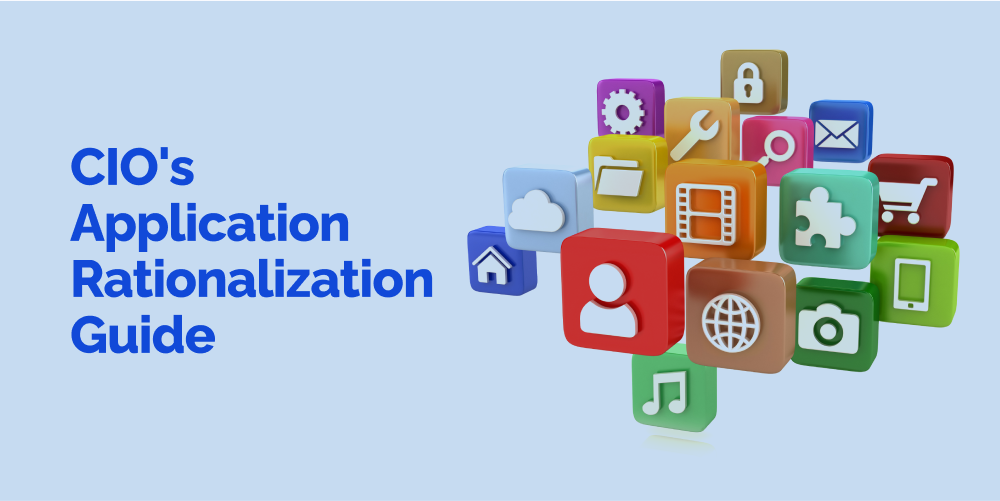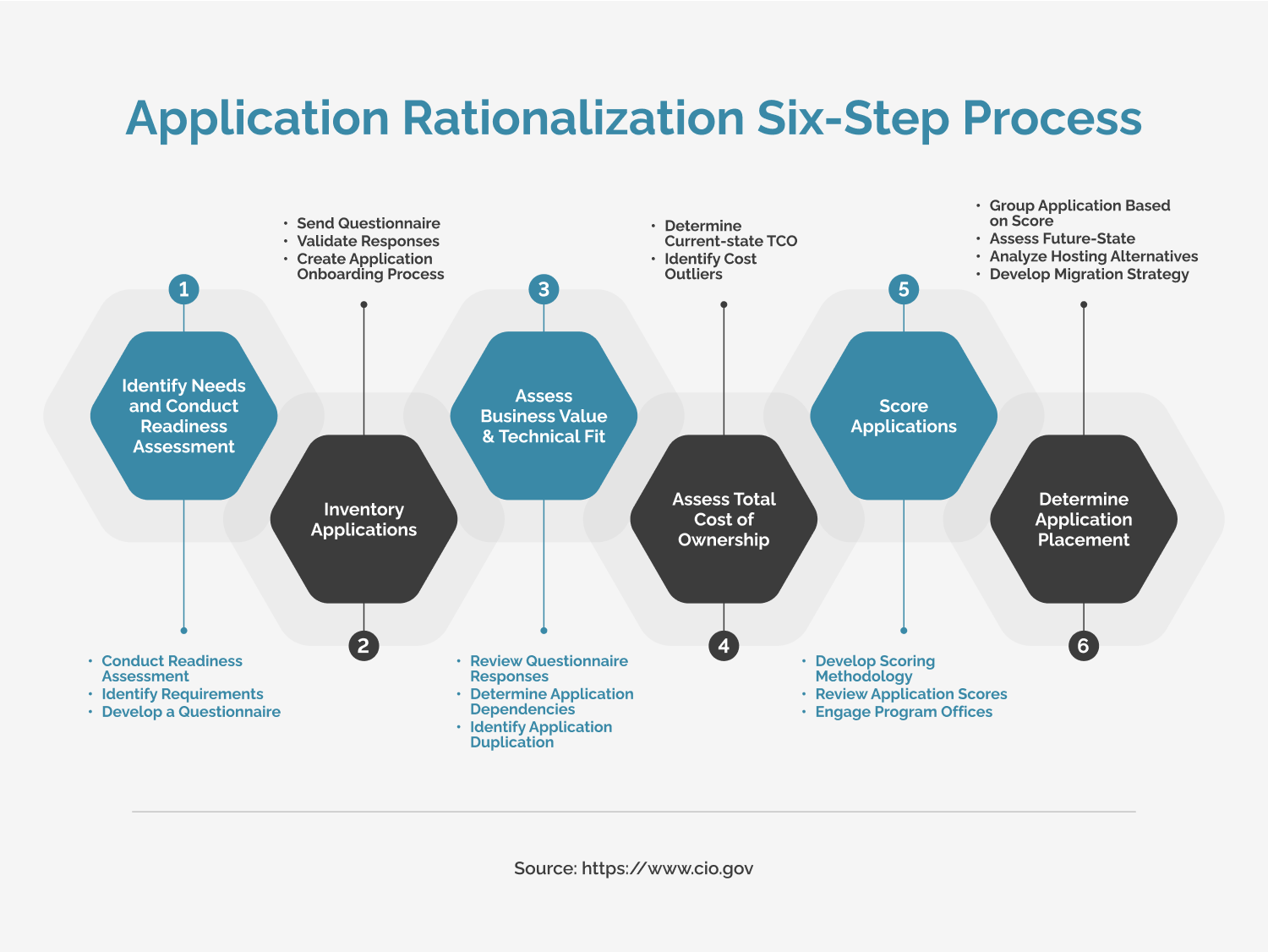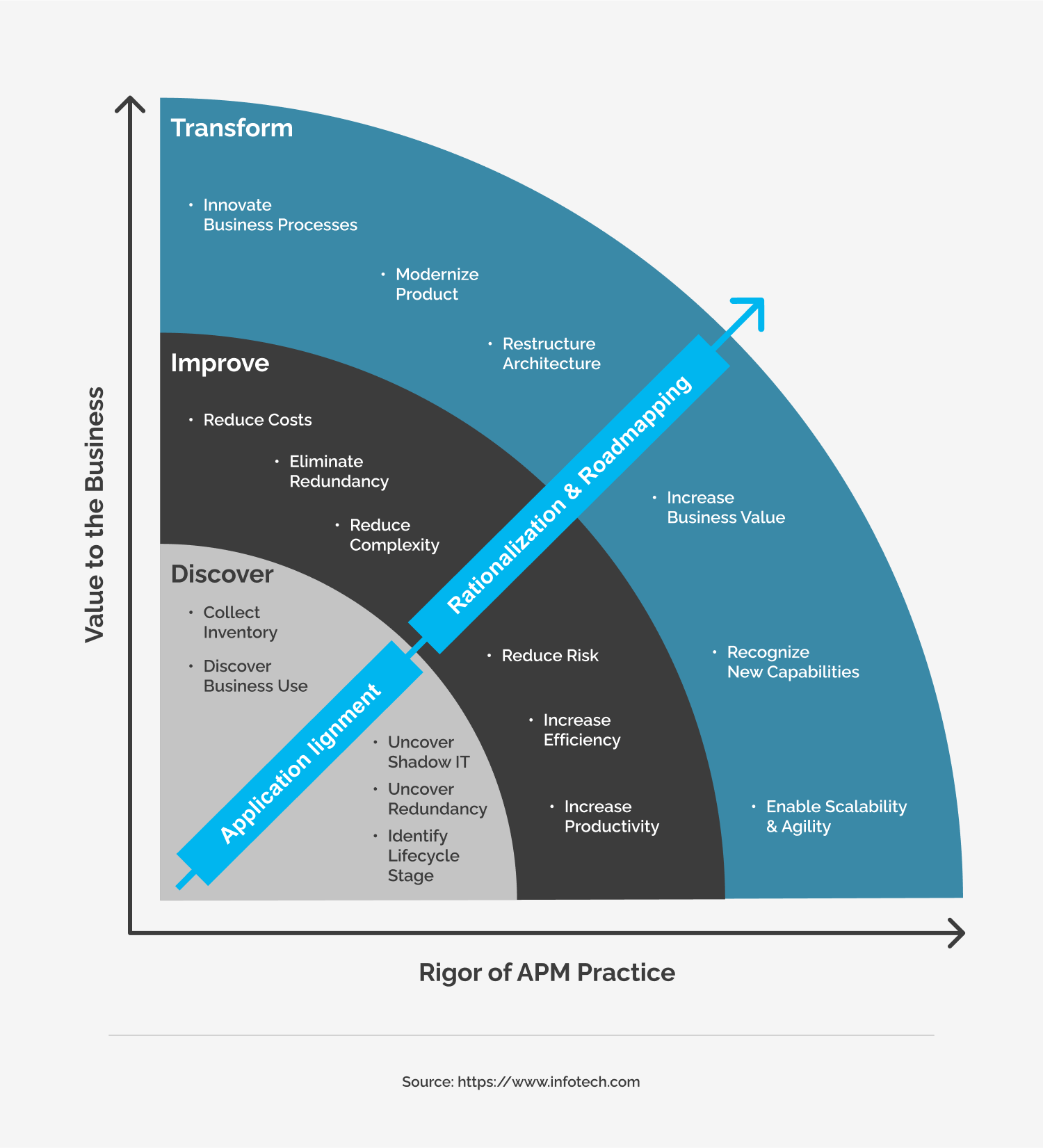Digital Transformation, zBlog
Driving Efficiency: A CIO’s Practical Guide to Application Rationalization
atif | Updated: October 30, 2023

Introduction
For today’s CIOs, managing a vast and complex application portfolio while optimizing resources and costs is a constant challenge. Application rationalization has emerged as a powerful strategy for CIOs seeking to streamline their IT environments and align them with core business objectives.
In this comprehensive guide, we’ll explore what application rationalization entails, outline the tangible benefits it offers, provide a step-by-step process, and showcase real-world examples of successful implementations.
What is Application Rationalization?
Application rationalization refers to the systematic process of critically evaluating an organization’s application portfolio to determine the business value and effectiveness of each application.
The goal is to identify and eliminate redundant, outdated, and underutilized applications to arrive at an optimized portfolio aligned with strategic priorities. This enables organizations to maximize their technology investments.
Key activities in application rationalization include:
- Comprehensive inventory of all business applications
- Assessment of application usage, costs, and value
- Classification into categories such as retain, retire, replace, etc.
- Prioritization and sequencing of application changes
- Development of retirement/consolidation roadmap
- Execution of roadmap to streamline the portfolio
Approached holistically, application rationalization facilitates both short and long-term benefits across critical areas like costs, productivity, and risk management.

The Pressing Need for Application Rationalization
The scale and complexity of enterprise application landscapes have exploded in the digital era. On average, large companies now use over 1,000 distinct software products and applications, with some utilizing as many as 10,000.
Much of this growth has been haphazard, driven by decentralized purchases and legacy systems staying in situ. The result is a labyrinth of interconnected applications, many of which are suboptimally used.
This application sprawl has become a massive resource sink for modern enterprises. Over 80% of IT budgets are spent just on maintaining current systems, leaving little for innovation.

Application rationalization has thus become a critical undertaking. Proactively optimizing the application portfolio and eliminating redundancies can free up resources to fund transformation. Other key drivers include:
- Reducing IT costs by retiring redundant solutions and related infrastructure. Studies show rationalization can yield over 25% in cost savings.
- Enhancing productivity by making it easier for employees to access the applications they need. Workers lose time navigating complex application landscapes.
- Supporting migration to the cloud by evaluating which applications should move versus stay on-premise
- Improving user experiences by decommissioning outdated or overlapping apps and delivering integrated platforms
- Mitigating business continuity risks by modernizing legacy applications and isolating mission-critical systems
- Achieving regulatory compliance by determining which applications require upgrades to meet evolving standards
- Facilitating M&A activity by rapidly consolidating newly acquired solutions into the environment
Faced with such motivators, nearly 70% of CIOs report having application rationalization initiatives underway or being planned.

Core Components of an Application Rationalization Program
Launching a successful enterprise-wide application rationalization program requires rigorous planning and execution across three key phases:
1. Discover and Assess
This phase focuses on developing a comprehensive inventory of all applications currently deployed, including shadow IT from business units. With the inventory in place, each application can be evaluated based on factors like:
the number of users and usage frequency
- Costs for licensing, personnel, hosting, and maintenance
- Alignment with business objectives
- Technical quality and architecture
- Vendor support status
- Security and Compliance risk
Collecting data through surveys, focus groups, and application performance tools provides objective insights into the value delivered by each system.
2. Categorize and Prioritize
With the assessments completed, applications are segmented into categories based on their strategic value and life cycle stage:
- Retain: Applications that are highly utilized and central to operations
- Replace: Aging applications that require modernization
- Retire: Underperforming applications that deliver minimal value
- Re-platform: On-premise apps that are strong candidates for cloud migration
- Enhance: Applications that need additional capabilities or integrations
The categories are then sequenced into a priority order for roadmap planning based on criteria such as redundancies, projected ROI, and interdependencies.
3. Execute and Measure
The final phase covers executing the rationalization roadmap and tracking progress. This requires attention to:
- Detailed plans for retiring applications, including data migration and business process transitions
- Change management and communication strategies to support affected users
- Re-training programs to bring users up to speed on replacement applications
- Governance protocols to ensure future application acquisitions align with target state architecture
Continually measuring costs, productivity, compliance, and other metrics provides visibility into outcomes achieved. Monitoring also highlights areas requiring corrective action.
Real-World Success Stories
Enterprises across industries have undertaken application rationalization to transform their IT environments. Here are two examples that demonstrate the benefits:
Manufacturing Company Consolidates 1700 Applications
A large manufacturing company had over 1700 applications, including many niche legacy systems from past acquisitions and factory installations. This complex environment made it difficult to respond quickly to business needs.
Through an application rationalization initiative, they identified and retired over 900 applications. They modernized several hundred more using cloud platforms and containers. The result was a much more agile, cost-efficient application portfolio with seamless integration between systems.
Key Outcomes
- 35% reduction in IT operational costs
- 28% improvement in time-to-market for new capabilities
- 520 legacy systems decommissioned
- $19 million in savings from application licensing and hosting
Healthcare System Boosts Productivity and Compliance
A major regional healthcare provider saw declining productivity as doctors struggled to navigate 140 disconnected health IT applications. They also faced compliance risks from running outdated systems.
By optimizing their portfolio, they reduced the number of applications by nearly half. Investments targeted modernizing clinical and patient management systems, leading to higher user satisfaction. Decommissioning legacy systems also supported HIPAA and other regulatory compliance.
Key Outcomes
- $8.4 million in annual IT cost savings
- 35% improvement in clinician productivity;
- Reduced risk of HIPAA violations through retiring outdated systems
- More than doubled user satisfaction with IT systems
Realizing the Benefits of Application Rationalization
As these examples demonstrate, application rationalization delivers tangible improvements in key areas when executed successfully. The most pronounced benefits typically include:
- Reduced IT costs by consolidating software licenses and system infrastructure. Average savings range from 20% to as high as 40%.
- Improved productivity across the business by streamlining access to information and capabilities. Users spend less time parsing through redundant systems.
- Enhanced innovation velocity comes from shifting budgets towards new capabilities versus supporting legacy systems.
- Greater business agility from having integrated data and more flexible application architectures.
- Stronger compliance and security posture by phasing out aging systems not aligned with modern requirements. Reducing the application footprint also minimizes risk exposure.
- Better user experiences through simplified application landscapes and modern interfaces customer satisfaction increases when exposed to fewer systems.
While every rationalization initiative is unique, employing the structured approaches outlined in this guide will help maximize the likelihood of achieving meaningful and lasting impact.
Making Application Rationalization a Priority
For companies struggling under the burden of bloated, disjointed application portfolios, rationalization may seem like an insurmountable undertaking. But given the immense potential efficiency gains, it is becoming an essential business priority.
With deliberate planning around discovery, assessment, categorization, execution, and monitoring, CIOs can transform the quality and strategic alignment of their application landscape. The recommendations in this guide serve as a practical starting point for building effective programs.

Application rationalization is a continuous process. As technology and business strategies evolve, so must the application portfolio. Maintaining constant vigilance – through governance, data-driven evaluations, and user feedback – is key to sustaining peak performance over the long term.
The time for action is now. CIOs that proactively lead rationalization initiatives will be best positioned to unlock resources, accelerate transformation, and deliver a foundation for the future built on innovation.
Conclusion
At Trantor, we have helped numerous clients optimize their application portfolios through our comprehensive rationalization services. Our experienced consultants leverage leading methodologies, proprietary tools, and hands-on guidance to deliver maximum value. We partner with clients throughout the end-to-end process – from assessments to roadmap creation and change management. If you are looking to transform the efficiency of your IT landscape, let Trantor’s experts guide you towards strategic alignment and sustainable gains. Get in touch today to learn more about our application rationalization capabilities.




